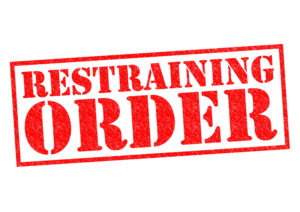Speak to a Lawyer About Filing a Restraining Order

If you live in fear of an abusive spouse, relative, boyfriend or girlfriend (even if they are an ex), or other parent of your child, you may need a restraining order to help keep you safe. While a restraining order may not be a physical bubble, nor does it mean that police officers will act as your bodyguards, having a restraining order in place against your abuser does give you some important legal recourse should they continue to harass you (or worse).
You may be wondering, “What do I need to get a restraining order?” and, “Do I need an attorney for a restraining order hearing?” Having an attorney at your side to help you through the process can be invaluable to maintaining your safety. Let’s look at what types of orders of protection exist, what you need to get them, and how each can keep you safe.
Domestic Violence: Difference Between Orders of Protection and Restraining Orders
Emergency Protective Order
If you are in immediate danger of domestic violence, call 911 and have the police petition a judge for an Emergency Protective Order. Special courts are open 24 hours a day, and deal only with emergency protective orders. Because this type of order deals with immediate danger, you may not have time to seek legal counsel first. Don’t worry about that. This petition is done ex parte, meaning that your abuser is not part of the process; it involves only the police officer and the judge. If the judge finds that you are, in fact, in immediate danger of domestic violence, they will enter the order. It gives you the same rights as a permanent restraining order, but only for a very limited time: either five business days or seven calendar days. During that time, you will need to petition for a full restraining order.
Temporary Restraining Order
Instead of a police officer petitioning for an order, you must petition the court for a temporary restraining order. A temporary restraining order is the first step towards receiving a permanent restraining order (also sometimes called a “protective order”). It is a good time to seek legal counsel whether you are married, filing for divorce or in a relationship.
For those getting a divorce, a restraining order will often set the tone for how a divorce case will be settled in court. Not only does it limit what one party can do, but how often they can return home with a restraining order in place. For those requesting court-mandated protection, this grants you more time to prepare accordingly. The entire process is fast. In this circumstance, retaining a Los Angeles divorce dispute lawyer that is well-versed in handling domestic abuse cases may be a good idea. It will give the attorney time to learn the facts of your case. The process also involves many forms that may require you to detail how your abuser has acted toward you.
The petition for a TRO is also done without your abuser, but it is only effective until the judge can schedule a hearing involving you and your abuser, where the judge will decide on entering a permanent restraining order. Usually, this is about three weeks from the date of the petition. The judge may set this date without any regard for your schedule, but do not let the date pass without either showing up or asking for a delay—if you do that, your case will be dismissed, and you will no longer be protected. A domestic violence attorney can ask for a continuance on your behalf and get the court to set the hearing for a day that works for you.
Restraining Order
A few weeks after you petition for a TRO, the judge will hold a hearing on a permanent restraining order. When granted, the judge will decide how long the order is in effect (typically five years). You may wonder, “Do I need an attorney for a restraining order hearing?” While it is not required, many people do want to have an attorney for such an important hearing. Also, an attorney can be a source of support during an emotionally difficult hearing that your abuser will be present at.
The order may cover many different things that your abuser will not be able to do while it is in effect, including:
- Assault, threaten, or harass you, your children, other people you live with, or your pets.
- Purchase or possess a firearm or ammunition.
- Stop paying certain bills, including the mortgage or rent.
- Go to any place that you request that the order include, such as your workplace, your children’s school, your friends’ homes, or somewhere that you are seeking shelter.
The order may tell the police to remove the abuser from your home and allow you to return to your home; grant you full control over things that you own, such as a car or bank accounts; and order the abuser to pay child support. The order may even force the abuser to pay for any medical bills that he or she caused you to incur, and to pay your attorney’s fees. If you are finalizing your divvorce, a Los Angeles attorney for asset management will facilitate the process accordingly.
Judges have a lot of discretion over what goes into these orders, but the petitioner must ask—judges will not do it on their own. This is where a good family law attorney in Los Angeles can help you organize your presentation in a way that makes sense in court. After the judge enters the order, it will have to be served on your abuser, but you cannot do this yourself (nor do you probably want to). Legal professionals can serve the order, and you will not have to see your abuser ever again. If your abuser continues to harass you, call the police: violating the order can be a felony, and your abuser will be arrested.
